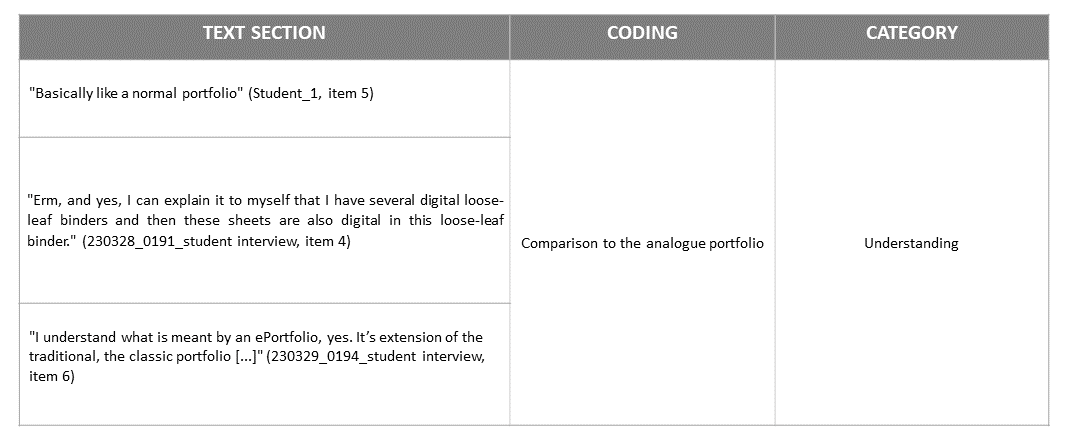DIFFERENT USE OF E-PORTFOLIO: EVALUATION & INTERPRETATION
1. Methodology
Interviews were conducted and analysed using MAXQDA as part of the research question of what similarities and differences can be identified in the perspectives of different target groups (students, teachers, pupils) with regard to the use of ePortfolios. The analysis was carried out both by coding and categorisation according to Mayring and by inductive category formation, whereby the categories emerged from the material. In addition, an analysis according to Mayring was conducted in order to gain deeper insights into the results.
To ensure systematic data collection, a catalogue of questions was drawn up in advance in close cooperation with various stakeholders, including the management of the Centre for Teacher Education (ZfL) at Justus Liebig University Giessen, consisting of Martin Reinert and Jeanne Flaum, as well as Claudia Spieler, the student group's internship officer, and Kristin Karl, an Erasmus project employee with extensive knowledge of ePortfolios and Mahara.
The survey is aimed at different target groups. These include students from Justus Liebig University Giessen, who are completing their general school internship (ASP) at the Max-Beckmann-Schule (Max Beckmann School) in Frankfurt. The Max-Beckmann-Schule is an upper secondary school where ePortfolio concepts are applied in different ways in the classroom. In addition to the students, teachers and pupils from this school are also interviewed. The interviews were conducted in five pupil groups, whereby the number of participants in the groups varied.
1. Methodology
In order to analyse the interview, the recordings were transcribed using a transcription AI. The transcripts serve as the basis for the analysis.
Qualitative content analysis is a common method of analysing qualitative interviews. The most frequently used method for interviews is structuring content analysis, in which a coding guide (e.g. according to Mayring or Kuckartz) is created. In order to create a coding guide, the statements from the interview must be assigned to different categories. Categories are deductively derived from the available data material (Mayring 2008, 602f).
Table 1 Example of coding according to Mayring

By using this procedure, based on the questionnaire, a total of 6 categories could be defined. As this is a pre-structured interview, this coding can also be applied to the question catalogue. No further categories emerged in the course of the interview. The following is an overview of the classification of the question catalogue based on this coding:
Table 2 Categorisation of the interview questions
